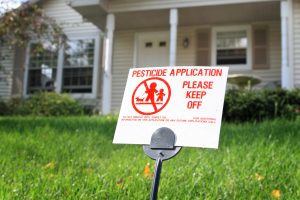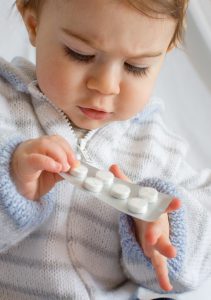In my last safety blog, we looked at knowing what poisons are, how children can come in contact with them, where to find them, limiting exposure to them, and knowing what to do in case a child comes in contact with them. In this blog, we’ll look at how to keep children safe from 5 common types of poisons.
Medications
Medications are attractive to young children because they are often brightly colored, look like candy or their favorite drinks, and may even smell good. To keep children safe with medications, remember the following:
- Keep high and out of the reach and sight of children.

- When possible, use child-resistant caps.
- Keep in original, labeled containers.
- Read and follow the Drug Facts label.
- Use any dispensing tool that came with the medication.
- Check the directions three times before giving to child.
- Ask the pharmacist or doctor any questions you may have before giving to child.
- Properly dispose of unused medications when past the expiration date. For information on the proper way to dispose of medicine, go to the U.S Food and Drug Administration.
Household and personal care products
Most of us have large numbers of household and personal care products. From cleaning products and paints, to cosmetics and mouthwash, the potential for poisoning is high. Such products should be kept in their original, properly labeled containers, and should be kept out of the reach of children. Most products will have a label indicating the active and inactive ingredients, human safety information, and what to do in case of accidental poisoning.
Pesticides
Pesticides present a high potential for poisoning. To keep children safe from pesticides, remember the following:
- Store pesticides in a shed or locked cabinet at least four feet off the ground, with dry products located above liquid products.

- Remove all toys, children, and pets from an area being treated with a pesticide until it has dried.
- Place any baits or traps in locations where young children cannot reach them.
- Read pesticide labels and use only as directed. Pesticide labels will contain signal words, warning and caution statements, and information on what to do in an emergency. For more information on what signal words mean, check out this information offered by Arizona College of Ag and Life Sciences Cooperative Extension.
Plants
Many of the plants we have in our landscapes and home have an irritant or poisonous affect. Know what plants are in your surroundings, and when purchasing plants, try to choose those that are low or non-toxic. There are at least 50 common indoor and outdoor plants that can cause skin and/or nasal irritations or that can be toxic if eaten. . For a list of common plants to be aware of check out the Florida Poison Control Center website. Teach your children to never put any part of a plant in their mouths.
Insects and animals
Florida is full of many different types of insects and animals, and most kids are drawn to them. Many insects and animals can cause harm through stinging, biting or spitting. These can cause reactions such as itching, blisters, irritation of eyes, and breathing difficulties. Stinging and Venomous Insects and Related Pests offers information on some common insects to be cautious of. As with plants, it’s important to teach children to be cautious around them, and only touch insects and animals that you know.
Preventing contact with poisons is always the best means of protecting our children. Taking a few minutes to look around the home, identifying potential poison hazards, and taking steps to limit contact with them will go a long way in helping to protect your children from them.
 0
0

